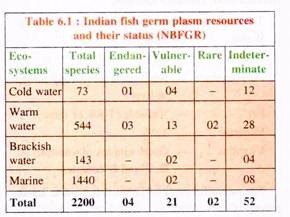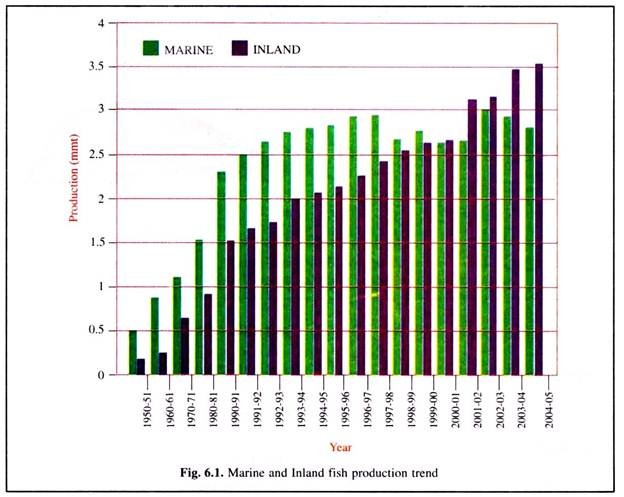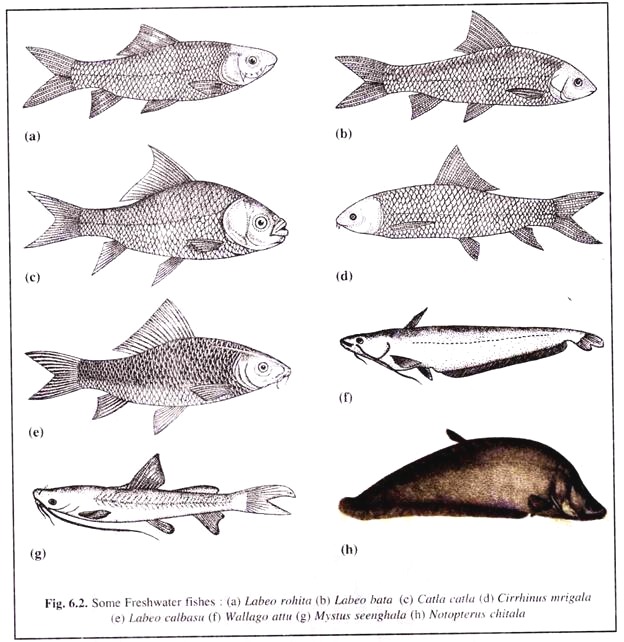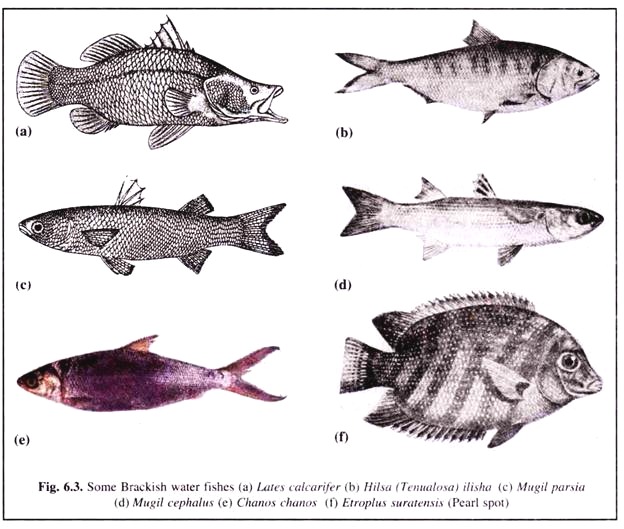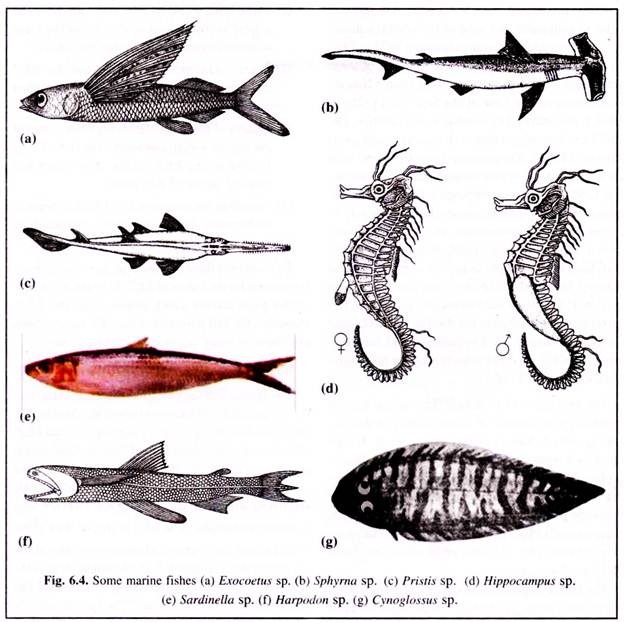In this article we will discuss about Fishery:- 1. Meaning of Fishery 2. Research Institutes of Fishery 3. Why Culture Fishes 4. Types 5. Exclusive Economic Zone.
Meaning of Fishery:
The term ‘fishery’ ordinarily means culture and propagation of edible and marketable fishes. This definition, however, should be restricted to pisciculture. Fishery is a vast domain.
In a broader sense it includes the judicious exploitation of natural resources of water for human consumption and benefit. The natural resources of water include all the organisms such as fishes, prawn, shrimps, crabs, sharks and rays, various molluscs, dolphins, whales, seaweeds, algae, etc.
The science of fisheries is a very complex subject. It is multidisciplinary and includes physical, chemical, biological, microbiological, hydrobiological, limno- logical, and meteorological sciences interacting with the biology of fish, ecology of the resources, production management, marketing, etc.
ADVERTISEMENTS:
Fishery science has expanded to such an extent that today various colleges and universities are running MSc courses in Zoology with specialisation in fish and fisheries or BSc, MSc courses exclusively in Fishery Science (BFSc and MFSc). Moreover, under the provision of U.G.C (University Grants Commission), a vocational course in Fishery Science or Industrial Fisheries is being run by a number of colleges and universities.
Apart from the above, a number of technological and Research Institutes, under the Indian Council of Agricultural Research (ICAR) are actively engaged in conducting research and evolving technological improvements for the betterment of fisheries.
Research Institutes of Fishery:
Some important Fishery Research Institutes are listed below:
(1) Central Inland Capture Fisheries Research Institute (CICFRI) with headquarter at Barrackpore (West Bengal).
ADVERTISEMENTS:
(2) Central Institute of Freshwater Aquaculture (C1FA) with headquarter at Bhubaneswar (Orissa).
(3) Central Institute of Brackish water Aquaculture (CIBA) with headquarter at Chennai (Tamil Nadu).
(4) Central Institute of Fisheries Technology (CIFT) with headquarter at Cochin (Kerala).
(5) National Bureau of Fish Genetic Resources (NBFGR) with headquarter at Lucknow (Uttar Pradesh).
ADVERTISEMENTS:
(6) National Research Centre on Cold Water Fisheries with headquarter at Nainital (Uttaranchal).
(7) Central Marine Fisheries Research Institute (CMFRI) with headquarter at Cochin (Kerala).
(8) Taraporevala Aquarium and Marine Research Station at Mumbai (Maharashtra).
Why Culture Fishes?
Fishes are advantageous for culture because:
(1) Fishes do not spend much energy on temperature regulation as they are poikilothermic in nature.
(2) Fishes can convert food into body tissue more efficiently than any other farm animals. The conversion factor to flesh is high in fishes (80.9%) than chicken (64.7%) and beef (51%).
(3) There is always a certainty of getting a rich haul from culturable waters than from natural resources.
(4) Fish is a prolific breeder. It has high fecundity.
(5) Fish production can be organised according to the market demand in respect of quality, quantity, size, colour, preservation and processing.
ADVERTISEMENTS:
(6) Low trophic feeders (herbivores) can be raised at comparatively lower costs than those which are higher in the food chain.
Indian Ichthyodiversity:
India globally ranks 3rd in fisheries and 2nd in aquaculture, contributing about 4.4% of the global fish production. This is mainly due to its vast diverse aquatic resources ranging from deep seas to lakes in the mountains and more than 10% of the global biodiversity in terms of fish and shellfish.
India’s marine wealth comprises 8129 km of costline and 2.02 million sq. km of Exclusive Economic Zone (EEZ). Its brackish-water and estuaries comprise 1.24 and 0.29 million ha, respectively. India’s freshwater resources comprise Rivers and Canals (1,97,024 km), Reservoirs (3.15 million ha). Ponds and Tanks (2.35 million ha) and Oxbow lakes and derelict waters (1.3 million ha).
In such varied aquatic ecosystems, India has vast and varied fish germ plasm resources comprising about 2,200 fish species. The total number of species reported worldwide is more than 24,618. The National Bureau of Fish Genetic Resources, Lucknow has identified fish germ plasm resources of India and their status (Table 6.1), from different ecosystems of the Indian waters.
Of 2200 species recorded, about 400 species are commercially important.
Types of Fishery:
I. Depending upon the management, fishery can be classified as under:
(a) Capture Fishery:
Capture fishery aims at the management and capture of fishes from the hill stream, rivers, lakes, estuaries and seas. Capture does not mean, over-harvesting. It is done with an eye to conservation of the fishes and other aquatic organisms, so that sustained productivity is maintained. This can be done by restricting the mesh size of the nets, so that smaller size fishes are not caught.
(b) Culture Fishery:
It includes the practice of rearing fishes in small impounded water such as ponds, jheels, small tanks, etc. Here important culturable fishes (endemic or exotic) are reared and bred on scientific lines and when they reach the desired length and weight, they are captured and marketed.
Nowadays, culture fisheries are also practised in large impoundments through pen or cage culture, mariculture, ranching (culture based capture fisheries), raft, rope, rack, tray or pole culture, etc.
II. Depending upon the habitat of fishes, fishery may be divided into following:
(A) Inland Fishery:
As has been discussed earlier, India has vast inland fishery resources. With increase in culture practices, the inland fish production (3.3 mmt) has overtaken the marine production (3.0 mmt) as shown in Fig. 6.1.
Inland fishery can be broadly subdivided into following:
(i) Freshwater Fishery:
Freshwater fishery comprises both capture and culture fishery. The aim is to culture fishes in small impoundments and to exploit fish resources from the great river systems of the country and from the vast networks of irrigation canals, lakes, tanks and reservoirs.
Some important freshwater fishes are as under (Fig. 6.2):
Carps:
Labeo rohita (Fig. 6.2a), Labeo bata (Fig. 6.2b), Catla catla (Fig.6.2c), Cirrhinus mrigala (Fig. 6.2d), Labeo calbasu (Fig. 6.2e), Labeo fimbriatus, Tor tor, Puntius sarana.
Catfishes:
Wallago attu (Fig. 6.2f), Ompok bimaculatus, Pangasius pangasius, Mystus seenghala (Fig. 6.2g) Mystus aor, Eutropicthyes vacha.
Jeol Fishes:
Clarias batrachus (Fig. 6.42a), He- teropneustes fossilis (Fig.6.42b), Channa striatus (Fig. 6.42d), Channa punctatus (Fig. 6.42e), Anabas testudineus (Fig. 6.42f), Channa gachua.
Feather-Backs or Knife-Fish:
Notopterus chitala (Fig. 6.2h), Notopterus notopterus.
Mullets:
Mugil sp.
Freshwater Eel:
Anguilla bengalensis.
(ii) Brackish Water Fishery:
It includes culture and exploitation of fishes from different bheris in the coastal regions, estuaries and brackish water ponds and jheels of the deltaic regions.
Some of the important fishes found here are — Lates calcarifer (Fig. 6.3a), Hilsa (Tenualosa) ilisha (Fig. 6.3b), Pangasius sp., Mugil parsia (Fig. 6.3c), Liza corsula, Mugil cephalus (Fig. 6.3d), Anchoviella sp., Chanos chanos (Fig. 6.3e), Etroplus suratensis (Fig. 6.3f), Osphro- nemus sp.
(B) Marine Fishery:
Exploitation of the fishes and other organisms of the sea comes under the preview of marine fishery.
(i) Coastal Fishery:
Marine fishery resources of a country are dependent upon a number of factors. The oceanographical features of the sea have a direct bearing upon the fish fauna and the nature of fisheries. The chemical nature of the sea water, nutrients and salt-contents determine the production of plankton which forms the food of fishes.
The currents, winds and upwelling of oceans also somewhat influence plankton production and exercise a great influence on the movements of fishes and their young ones. Moreover, the continental shelf (the land beneath the sea), its area and slope, also to some extent determine the facilities of fishing.
India has two main seas, the Bay of Bengal on the east and the Arabian sea on the west. Both the seas are radically different from each other.
The Coromandel or eastern coast has a narrow continental shelf that declines sharply into the deep sea waters. The circulation of water in this coast is less pronounced as the north-east monsoon winds which sweep over the Bay of Bengal and are moderate as well as of short duration. Upwelling is not observed, except for a certain degree which has been observed in the Andhra zone.
This has resulted in comparatively poor plankton production in the Bay of Bengal. Moreover, the deltas of the large rivers flowing into the Bay of Bengal and the several coastal lakes provide estuaries with their characteristics of fishery resources. The influence of these physical, chemical and biological factors, reflect on the availability of different varieties of fishes and their quantity.
On the other hand, the Malabar or west coast has higher fish production, both qualitatively and quantitatively, than the east coast.
This may be attributed to the following facts:
1. The continental shelf is broader.
2. The south-west monsoon is longer and stronger.
3. The somali ocean current from the eastern coast of Africa moves northwards, sweeps around the head of the Arabian sea and then drifts along the west coast of India.
4. The upwelling of the sea water is more pronounced and brings about a better circulation in the sea.
5. The seasonal cycles of the sea water of Arabian sea are more pronounced.
All these leads to higher plankton (food of fishes) production and thus, richer fish fauna. It is estimated that about 75% of the total marine landing comes from the west coast.
Some of the fishes that are captured from the coastal area are listed below:
i. Sharks:
Scoliodon sp. (dogfish), Sphyrna sp. (Hammer-headed shark) (Fig. 6.4b), Carchar- hinus sp. (Blue shark), Rhincodon sp. (Whale shark), Galeocerdo sp. and Stegastoma sp. (Tiger or Zebra or Carpet or Nurse shark).
ii. Rays:
Pristis (Sawfish) (Fig. 6.4c), Rhino- batus sp. (Guitarfish), Torpedo sp. (Electric Rays), Aetobatus sp. (Eagle rays), Rhinoptera sp. (Cow-nosed rays), Dasyatis sp. (String or Whip or Butterfly rays).
iii. Skates:
Raja sp.
iv. Sardines:
Sardinella sp., Dussumiera sp., Kowala sp.
v. Mackerel:
Rastrelliger sp.
vi. Bombay-Duck:
Harpodon nehereus (Fig. 6.4f).
vii. Ribbonfish:
Trichiurus sp.
viii. Jewfish:
Pseudosciatna sp., Otolithoides sp.
ix. Pomfrets:
Stromateus sp, Chondroplites sp., Formio sp.
x. Indian Salmon:
Eleutheronema sp., Polynemus sp.
xi. Seerfish:
Scomberemorus sp.
xii. Flying Fish:
Exocoetus sp. (Fig. 6.4a)
xiii. Pipefish:
Syngnathus sp.
xiv. Soles:
Cynoglossus sp. (Fig. 6.4g)
xv. Tunas:
Gymnosarda unicolor (dog tooth tuna), Thunnus alalunga (big eye tuna).
xvi. Other Fishes:
Silver bellies, eels, Hippocampus sp. (seahorse) (Fig. 6.4d) red mullets.
(ii) Offshore and Deep Sea Fishery:
The area beyond the continental shelf is the expansive sea which is rich in various kind of fishes. These fishes dwell either at the surface, mid-water or at the bottom of the sea and their exploitation constitutes offshore and deep sea fisheries.
The most profitable depth is 20 fathoms (37 metres) and the catches are better during the day than night and also during neap-tide than spring-tide. Various types of trawlers and trawling nets are in operation.
The important commercial fishes found in this area are:
Sharks — Carcharhinus sp., Pristis sp.
Indian salmon — Eleutheronema tetradactylum
Giant headfin — Polydachylus indicus
Jewfish — Pseudosciaena diacanthus
Sea eel — Muraenosox sp.
Perches — Epinephelus sp., Lutianus sp.
Exclusive Economic Zone (EEZ) for Fishery:
Exclusive Economic Zone (better known as EEZ), was the outcome due to a conflict on the fishing rights among coastal nations. It resulted due to the fact that some nations found that their waters were being exploited by foreign countries equipped with better and more powerful fishing gear and craft, more sophisticated navigational and fish detection systems than their own.
Several such exploited countries joined hands in 1950s and together unilaterally established fishing limits in their coastal waters for exclusive fishing. Initially, the limit was only six to twelve miles. Subsequently many more countries joined hands and by 1970s established an extended limit of 200 nautical miles (1 nm = ~ 1.85 km).
Later, the United Nations General Assembly in order to nationalise the need of the coastal nations, convened several conferences between 1974 to 1982 on the Third Law of the Sea. The outcome of these delebrations was the formation of the United Nations Convention on the Law of the Sea (UNCLOS) in 1994. It was attended by as many as 60 countries.
The UNCLOS formulated that each coastal country will have an EEZ of 200 nm zone from the shore with exclusive right to exploitation of marine resources. The UNCLOS has also imposed certain responsibilities on them, that each country shall have a duty to properly manage its resources.
In case the resources are not fully tapped by a country, then other countries shall have the legal right to exploit such waters. The fisheries beyond the EEZ (high sea) was stated to be regulated by the Regional Fisheries Organization. The agreement was reached at the Rio De Janeiro United Nations Conference on Environment and Development (UNCED) in 1992, which is under the framework of the UNCLOS.
The imposition of EEZ to 200 nm posed a lot of problems to a number of ocean-fishing countries, among which Russia suffered the most. It had developed enormous technology and fishing fleet to explore fisheries around the globe including Antarctica (for krill).
The implementation of EEZ deprived Russia to get access to these fertile fishing grounds except its own EEZ. Thus, its earnings from fisheries have been badly hit. The same problem was also faced by Japan, Spain, etc.
The EEZ comprises a stretch of water from 12 to 200 nautical miles. The inshore coastal water fisheries up to 12 nm remained with the traditional and artisanal fishermen for exploration.
EEZ had changed the fishing pattern. However, many countries including India faced a number of problems such as:
(1) Many countries found it difficult to explore new waters of EEZ that were not only too far out but deep also, and they lacked proper gear, vessel and technical know-how. The only solution to this problem was to have joint ventures with foreign countries who have the expertise and experience.
(2) Many third world countries did not have the capital to purchase expertise, technology and to recruit experienced foreign personnel.
(3) Some countries over-exploited the EEZ causing damage to the inshore fishery, often evoking unrest.
(4) Quality offish is another aspect that comes in the way of selling and marketing fish to keep fishing in the EEZ viable. This often has resulted in rise of fish price.
(5) Patrolling the vast stretch of EEZ has become problematic. This has resulted in fish poaching in unprotected water.
To overcome these problems proper management is essential for the future of EEZ. In India about 90% of the total marine catch comes from the EEZ. However, the full potential of the EEZ has not been exploited by many countries including India.
Indian Exclusive Economic Zone:
The Indian Exclusive Economic Zone came into force through the 41st Amendment of the Article 298. India is one of the signatories (flag states) of the EEZ. With the adoption of the United Nations Convention on the Law of the Sea (UNCLOS), India obtained a wide exclusive economic zone (EEZ) of about 2.02 million sq. km in the sea all along the 7500 km long coastline around her.
The EEZ is almost ⅔ rd of the inland area of the country and comprises 0.86 million sq. km on the west coast, 0.56 million sq. km on the east coast and 0.60 million sq. km around the Andaman and Nicobar islands. The species composition of EEZ includes tuna, anchovies, perches, ribbonfish, lizardfish, catfish, shark, rays and skates, squid, cuttlefish, bivalves, shrimps, lobsters, crabs, etc. Of these, shrimps are the most exploited.
India presently has been able to actually exploit only inshore water (up to 50 m depth), while the offshore water (beyond 50 m depth) has largely remained unexploited. This has resulted in India being unable to tap the full potential of this region which has been estimated to be 3.9 to 4.5 million tonnes.
Fishing beyond the 50 metres depth is negligibly exploited due to lack of infrastructure. Of the total estimated potential in this zone, 70% is constituted by pelagic resources, 19% by demersal resources and the rest by variety of low-value fishes, crabs, etc.
Deep sea holds enormous scope, and fishing in this region is, therefore, a matter of great concern and attention. Moreover, to check poaching of unauthorised intrusion into the Indian EEZ, fast and well-equipped patrol vessels should undertake survellance as well as search and rescue works in the EEZ.
The Indian EEZ resources to the tune of 3 million tonnes per year has remained unexpolited. Strategies have been planned for exploration and exploitation of the EEZ resources. Deep sea fishing policy was brought into force in 1991.
Joint ventures with foreign countries were tried up to 1983. The deep sea fishing policy in India was not welcomed by the traditional and artisanal fishermen and their association who opposed strongly, particularly the joint ventures with foreign countries.
Several million people living along the coastline are directly influenced by oceanography of the EEZ, various environmental hazards and related social issues. Thus, it is essential to comprehensively map the entire EEZ so as to understand the natural processes that have been active in EEZ.
The National Institute of Oceanography (NIO) has initiated the process to explore the Indian EEZ. This enormous task has been undertaken in collaboration with other national institutes, like NIOT (Chennai), NCAOR (Vasco), GSI and some universities.
